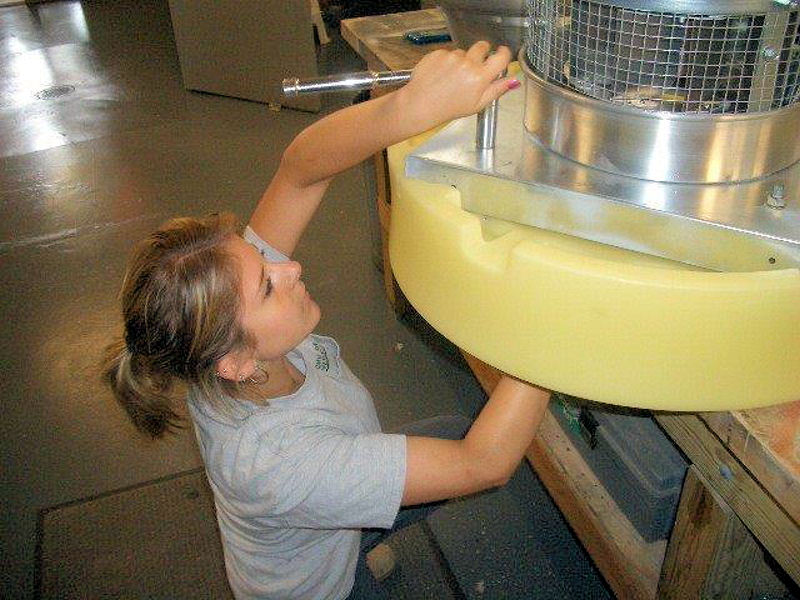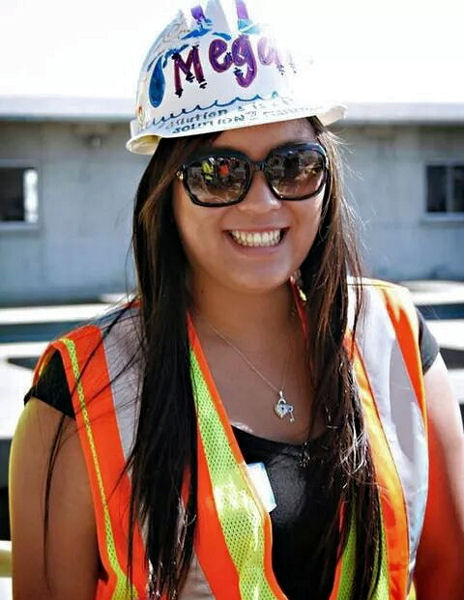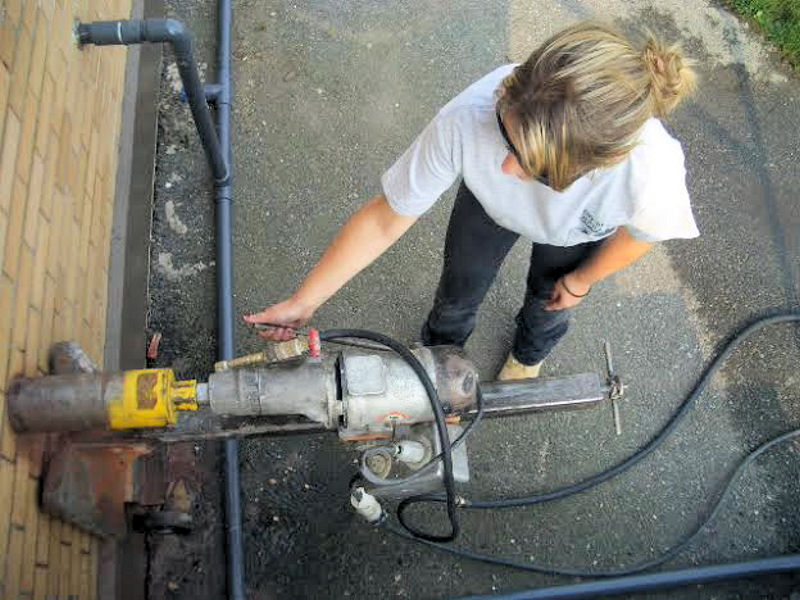
Kelsey Reeves, former intern of the Groton (Conn.) Water Pollution Control Authority, works on a biofilter project. Photo courtesy of Kevin Cini, chief plant operator for the City of Groton.
Let’s face it: To the average high school junior, the thought of building submarines rates significantly higher on the coolness scale than the thought of operating a water resource recovery facility (WRRF). And Kevin Cini knew it.
That fact became even more abundantly clear 10 years ago when Cini looked around the WRRF he operates in Groton, Conn. The city also is home to General Dynamics’s Electric Boat division, the primary builder of U.S. Navy submarines.
“At that time, I was 42 years old, and I was the youngest employee here,” Cini said.
Concerned about the city’s ability to recruit a new generation of wastewater professionals, Cini contacted the dean of students at the local technical high school to see about developing an internship program.
Today, two of the Groton Water Pollution Control Authority’s six full-time employees are former interns under the age of 25, and a steady stream of their peers would like nothing more than to join them.
Summer internships lead to bigger, better things
High school internships like the one offered through Ella T. Grasso Southeastern Technical High School in Groton are a successful recruiting tool for utilities with aging workforces. And, at least in Cini’s experience, they produce top-notch candidates who otherwise would not have considered this career option.
Working through Grasso Tech’s Bioscience and Environmental Technology Department, the wastewater facility today hires one summer intern each year from the school’s junior class. Candidates participate in an interview process that involves not only themselves, but also their parents and the school’s dean of students.
“I let the students and parents know what our expectations are from the very beginning,” Cini explained. “We want students to know that this can be a long-term, family-sustainable job.”
The selected intern is paid $12.50 an hour to work full-time for 6 weeks in the summer, during which they are exposed to the full spectrum of facility operations. Interns who perform well and show interest are invited to stay on and work at the WRRF half-time until they graduate the following spring.
Because the tech school is state-funded, student interns have liability insurance. “That’s what makes it possible for them to have a safety-related job, even though they are under 18,” Cini explained.
“In the beginning, we had to really encourage students to apply and coach them through the process,” he said. “But now it’s not uncommon for 8 to 12 students to apply for a single position.”
Because of the program’s popularity, it has since expanded to include internships with the city’s water and electric utilities.
Cini said the program has been gratifying on many levels. In addition to the two interns who have been hired on as full-time employees, the program also has produced a third student who is now studying environmental engineering at the University of Connecticut (Storrs, Conn.). “Coming in, she told us she wanted to be an architect,” Cini said.
Another former intern went on to serve in the U.S. Army Special Forces, where his platoon was called on to rebuild a WRRF in Afghanistan. “He later came back to thank me for the training we gave him,” Cini said.
Texas program prepares students for licensing exam
High school students who participate in the Irving (Texas) Independent School District HydroTechnology Program not only have internship opportunities, but also are prepared to take licensing exams that give them a leg up when seeking employment after graduation.
Started in 2008, the program includes courses at a local high school that prepare students for the Class D Water or Class I Wastewater Collections licensing exam. The course also helps them earn the 20 credit hours needed for licensure. Taught by Barry Allen, Water Program specialist for the City of Irving, the 1-day-a-week classes follow manuals approved by the Texas A&M Engineering Extension Service (College Station, Texas).
“In addition to technical information, we also teach them about the kind of jobs available in our industry,” Allen said. The 10- to 15-person class also takes field trips, including one to the lake near the WRRF for a fishing derby,” Allen said. “Afterward, we take the fish back to aquariums where we monitor their health, and the students learn how to test the water for nitrates, ammonia, and other chemicals.”
From the class, the city chooses two to three unpaid interns each year who spend an hour every Tuesday through Friday morning at the city’s WRRF performing various tasks. Two recruits have since joined the staff full-time, with others receiving their licenses and finding employment at other local water and wastewater utilities.
Interest in the program is growing. A similar program has been offered in Waco, Texas, since 2009. Three additional Texas schools also are making plans to get involved, Allen said.
National opportunities
Not every high school can sponsor outside internships. But they can still interest students in water and wastewater careers through promotion of such programs as the Stockholm Junior Water Prize (SJWP).

Megan Yoo Schneider won California’s Stockholm Junior Water Prize competition 2 consecutive years and now works at a consulting firm in the water sector. Photo courtesy of Yoo Schneider.
Open to all high school students and sponsored in part by the Water Environment Federation (WEF; Alexandria, Va.), the annual competition offers young people the opportunity to conduct their own water and sustainability research, according to David Wagoner, chairman of WEF’s SJWP Committee. National winners travel to Stockholm, to present their research at the World Water Week conference and have the chance to win up to $15,000.
“The students who participate understand that water is precious, and their research tends to look at ways to protect it or to make it safer for us to use,” Wagoner said. “The fact that it can also interest them in a career in water or wastewater is a tremendous bonus.”
It is indeed gratifying to see that light bulb of interest turn on, Allen said.
“I can’t tell you how rewarding it is to watch a student get excited about what we do,” Allen said. “But the bottom line is, we also need them.”
— Mary Bufe, WEF Highlights
Learn More About ‘Growing the Workforce’This is the second in a “Growing the Workforce” series exploring efforts in the water sector to increase high school students’ knowledge and interest in treating water. The first in the series, “Growing the Workforce: Looking to the Future,” describes scholarship and grant programs to promote students’ education about and involvement in the water sector. The third in the series will appear in Highlights in July. The article describes how students who have participated in internships and other programs are involvement in the water sector. |









June 26, 2014
Featured